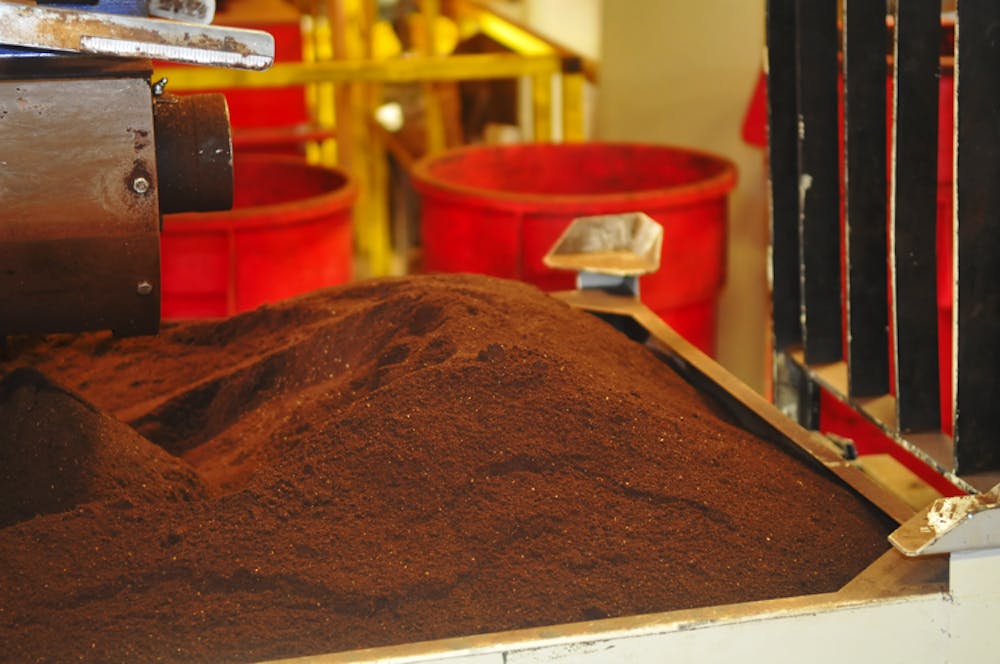[media-credit id=2 align="alignleft" width="300"][/media-credit]
Todd Carmichael, co–founder of the Philadelphia based coffee roaster, gave us a behind the scenes look at coffee’s journey from green beans in a burlap bag to a brewed cup o’ Joe in your favorite mug.
Coffee’s bold and smooth aroma permeates the entire La Colombe roasting facility; the factory smells like Sunday morning breakfast in your family's kitchen, but the clanging of industrial equipment replaces the soothing drip of a coffee maker.
Todd showed us some of the fancy machines, including one of the oldest working coffee roasters in the world. He quickly weaved through the equipment to point out the different stages of roasting. Beans receive treatments of heat, cooling and nitrogen (to prevent oxidation and degradation of the bean), and end their travels packaged and ready for shipment.
“Everyone should have access to a great cup of coffee! It should be in the Constitution!” says Todd. His emphatic devotion to this commodity (the second most traded on the market) may seem overzealous, but his proclivity for java is genuine and refreshing. He divulged some little–known facts and tips about coffee:
Ditch Robusta, Choose Arabica Unless you plan to “fuel a space shuttle,” throw your Robusta coffee beans in the trash. This harsh and acidic species of coffee boasts three times the caffeine content of Arabica beans, but its taste pales in comparison. Arabica has a much more nuanced and smooth flavor. No respectable coffee provider would ever consider roasting Robusta beans.
[media-credit id=2 align="alignright" width="300"][/media-credit]
Decoded Coffee Lingo Varietal — refers to the actual type of plant grown (for example, Typica, Bourbon and Thompson). Origin — region of the world in which the coffee plant is grown. Blend — a roaster’s unique mix of multiple varietals to lend an enticing but balanced flavor. Every origin has its own unique set of factors that affects the bean's flavor: soil, weather, altitude. Different varietals can be planted in different regions of the world. If various varietals were planted in the same place, each varietal would taste distinctly different. Likewise, if the same varietal were planted in different origins, the beans would have a unique flavor.
Respect Yo' Beans Todd urges you to treat coffee like spice. “You don’t store nutmeg in the freezer!” If you did, the oils that impart flavor would crystallize and neutralize the taste. Be kind to your coffee. Don’t freeze it. Don’t store it for months and years. Buy coffee in a small enough amount that you can consume it within 15 days, the maximum ideal storage time.
Conscious Consuming Second to water, coffee ranks highest among most consumed beverage in America. This beverage is so ingrained in our everyday routine that Todd says it is “the life blood of millions” — the third world’s livelihood. Look for labels of quality, and keep in mind that USDA Organic is not the end all be all of qualifications. Look for the Rain Forest Alliance logo on your next bag of coffee; this seal of approval, which Todd “love, love, loves” strikes a balance between maintaining healthy standards and ensuring quality of life for the farmers.
Do It Your Way Todd knows the science, the business and the agriculture, but the “crossroads of [his] life is flavor.” His palate knows coffee, yet he insists that taste is dependent on the drinker's taste buds. If you like milk, sugar or dare we say 4 packs of artificial sweetener, your coffee is yours, so enjoy it! Forget the flowery description of each blend; the lemongrass, caramel, floral and citrus notes don't mean anything if you don’t like the taste of the fancy ingredients.







